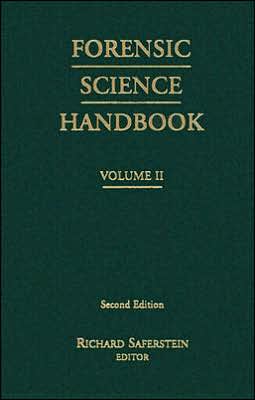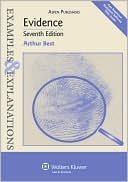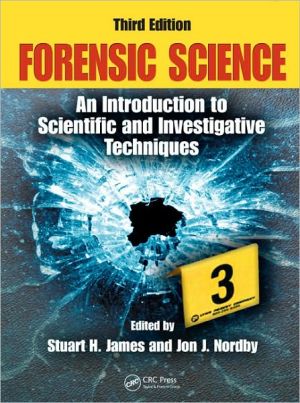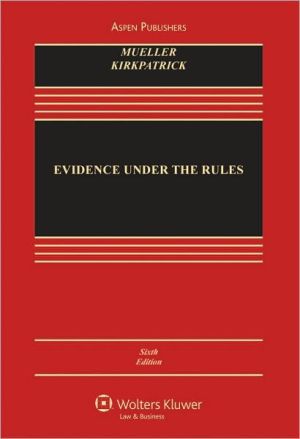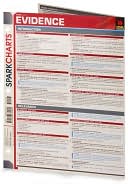Forensic Science Handbook, Vol. 2
Designed to provide practicing scientists with extensive knowledge and reference material to support scientific testimony in the courtroom, this book presents authoritative, updated reviews designed to familiarize the reader with the latest techniques and methods available to forensic scientists. Practitioners will find this volume and its two other companions to be a handy reference for acquiring a working knowledge of examination techniques for a wide-range of crime-scene evidence. This...
Search in google:
Concentrating on the application of scientific principals in the crime lab, this volume addresses the legal aspects of forensic science, the applications of current technologies, and the examination of specific substances. Individual chapters cover high-performance liquid chromatography and capillary electrophoresis, mass spectrometry, microscopy, visible microscopial spectrophotometry, and the examination of glass, hair, paint, soil, blood, and documents. The contributors are forensic scientists, research chemists, toxicologists, microscopists, and scholars of criminalistics associated with universities, law enforcement agencies, and consulting firms. Annotation c. Book News, Inc., Portland, OR (booknews.com)
The publication of the second edition of Forensic Science Handbook-Volume 11 provides the opportunity to report on subjects relevant to the practice of modern criminalistics. As with volumes I and III of this series, it is the intended purpose of this book to publish survey chapters incorporating a wide range of subject areas relevant to the services rendered by crime laboratories and related facilities. From the outset, it has been the objective of the editor to select recognized experts to compose in-depth, authoritative reviews in their specialized areas of expertise. To this end, the editor owes a debt of gratitude to all the contributors who have labored to make the publication of the Handbook series a reality.\ The editor feels that the Forensic Science Handbook series fills a void in the literature of forensic science. During the past ten years there has been a meteoric rise in academic courses and programs in forensic science. For the most part, existing books on criminalistics are not designed to provide the reader with in-depth, wide-ranging reviews on a spectrum of relevant subjects. This predicament becomes apparent when instructors must select an advanced text for graduate or undergraduate courses in forensic science. Volume II is a collection of chapters on subjects essential to the practice of criminalistics. Given the nature of the criminalistics enterprise, the subjects are wide-ranging, extending from the identification of biological stains to firearm identification, and from textile fiber examination to mitochondria) DNA.\ Chapters devoted to specific analytical technologies (i.e., capillary gas chromatography and microscopic techniques) have been included because of their importance to criminalistic laboratory practices. Chapters 1 and 2, entitled "Mountebanks among Forensic Scientists" and "More Mountebanks," stress the relationship of forensic science to judicial rulings and procedures while exploring ethical considerations regarding the conduct of expert witnesses. The basic integrity of forensic science rests with an honest presentation of the expert's credentials and data during courtroom testimony. Finally, the book includes a broad but detailed survey of the forensic aspects of drug identification. Emphasis has been placed on giving the reader an insight into the philosophy and strategies of forensic drug analysis.\ Sadly, Barry Gaudette, the original author of the chapter entitled "An Introduction to the Forensic Aspects of Textile Fiber Examination," passed away as this volume was being revised. Barry's illustrious career with the Royal Canadian Mounted Police's forensic laboratories spanned thirty-three years. His chapter and his many other published works are a testament both to Barry's skills and to his devotion to forensic science.\ I wish to express my appreciation to a number of individuals who reviewed and commented on the manuscript: Tom Brettell, Larry Kobolinsky, Vincent Cordova, Andrew Nardelli, Jay Siegel, and Charles Tindall.\ The views and opinions expressed in this book are those of the contributors and do not necessarily represent those of any governmental agency.\ Richard Saferstein, Ph.D.
PrefaceCh. 1Legal Standards for the Admissibility of Novel Scientific Evidence1Factors Affecting Reliance by the Courts on Scientific Evidence2The Motion in Limine3Standards for Admissibility5Ch. 2A Guide to the Analysis of Forensic Dust Specimens24Occurrence, Collection, and Preservation of Dust Specimens26Initial Examination30Characterization and Identification Procedures32Ch. 3Forensic Applications of Infrared Spectroscopy71Theory73Specificity and Limitations of Infrared Spectroscopy95Instrumentation103Sampling Techniques and Accessories116Applications130Future Directions159Ch. 4Infrared Microscopy and its Forensic Applications196Optical Design198Spectral Measurement Methods and Sample Preparation214Applications221The Future245Ch. 5Forensic Pharmacology253Basic Principles of Pharmacology254Other Drugs of Interest to the Forensic Scientist280Ch. 6Deoxyribonucleic Acid Structure and Function - A Review287Chemical Composition289The Watson-Crick Model of DNA295Central Dogma301The Genetic Code302Methylation of Bases in DNA306Transaction and Translation307Introns311Chromosome Structure312DNA Synthesis in the Cell Cycle314Repetitious DNA323Restriction Enzymes327Mitochondrial DNA330Plasmids as Gene-Cloning Vectors332DNA Profiling (RFLP Analysis)333DNA Sequencing337Production of Transgenic Animals344Gene Therapy345Medical Benefits, Legal and Ethical Considerations346Ch. 7Forensic DNA Typing of Highly Polymorphic VNTR LOCI358Fundamentals of DNA Structure359Genetic Markers Used for Forensic RFLP Typing361The RFLP Typing Procedure363Interpretation of RFLP Typing Results381Validity and Reliability of RFLP Typing and Data Interpretation389Appendix 7.1 Guidelines for a Quality Assurance Program for DNA Analysis398Ch. 8DNA Analysis in Biological Evidence: Applications of the Polymerase Chain Reaction416The Polymerase Chain Reaction417Detection of Genetic Variation424Determination of Sex and Species Origin433Biological Evidence Analysis Using PCR435Interpretation of Results: Statistical Considerations442Index453
